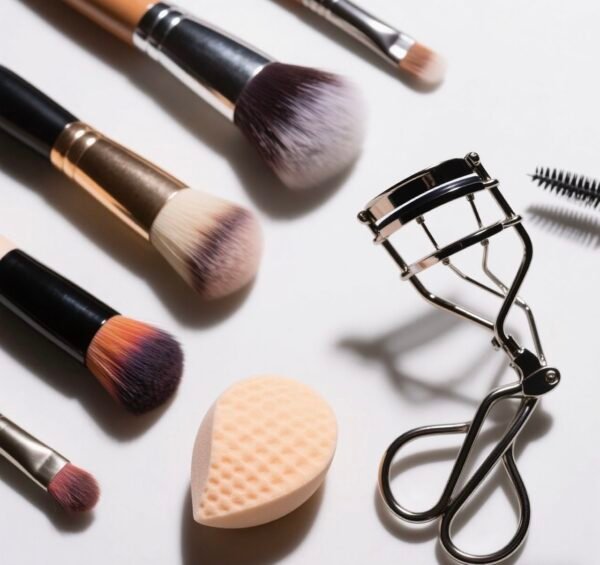Introduction
Beauty tools are essential for daily grooming and professional makeup artistry. From makeup brushes and sponges to tweezers, eyelash curlers, and dermaplaning blades, these tools repeatedly come in contact with skin, hair, and bodily fluids. Despite routine cleaning practices, microbial contamination remains a persistent and underestimated risk within personal beauty routines and salon operations.
Integrating antimicrobial agents into beauty tool materials presents an innovative solution to elevate hygiene standards, protect user health, and reinforce professional credibility in an industry where cleanliness equates to trust.
Microbial Risks in Beauty Tools: An Invisible Threat
Why Beauty Tools Harbor Microbes
- Direct Contact with Skin and Fluids
Brushes accumulate sebum, sweat, and dead skin cells, providing - Infrequent Cleaning
Studies reveal that consumers clean makeup brushes less than once per week on average. Professiona - Shared Usage in Salons
Multi-client use increases cross-contamination rPropionibacterium acnes), Staphylococcus aureus, and fungal species.
Common Contaminants and Associated Health Risks
| Tool Type | Microbial Threat | Potential Impact |
|---|---|---|
| Makeup brushes | Staphylococcus aureus, Pseudomonas aeruginosa | Skin infections, folliculitis |
| Beauty sponges | Candida spp., bacteria | Fungal infections, acne exacerbation |
| Tweezers & eyelash curlers | Skin flora bacteria | Conjunctivitis, follicle infections |
| Dermaplaning blades | Bacteria from skin microabrasions | Local infections, delayed healing |
Antimicrobial Agents: Mechanisms and Beauty Tool Applications
Silver-Based Agents
- Mechanism: Silver ions disrupt bacterial membranes and interfere with DNA repl
- Applications: Brush handles, synthetic bristles, sponge polymers.
- Advantages: High efficacy at low concentrations, color-neutral integration, durable protection resistant to washing.
Copper-Based Agents
- Mechanism: Generates reactive oxygen species that damage microbial proteins and DNA.
- Applications: Metal tweezers, eyelash curlers, dermaplaning tools.
- Advantages: Effective antibacterial and antifungal activity, ideal for alloy-based tools.
Zinc-Based Agents
- Mechanism: Inhibits essential microbial enzymes, slowing or halting growth.
- Applications: Sponge materials, silicone-based beauty tools.
- Advantages: Mild, broad-spectrum protection, cost-effective for mass production.
Manufacturing Integration and Technical Considerations
- Polymer Compounding
Silver or zinc-based agents are compounded into plastic masterbatches for brush handles, sponge foams, and silicone tools to ensure homogeneous dispersion and long-lasting antimicrobial action.
- Metal Alloy Incorporation
Copper is integrated during alloy formulation for tools like tweezers and dermaplaning blades, embedding antimicrobial properties directly within the material structure.
- Surface Coating (Limited Use)
While antimicrobial coatings can be applied to tool surfaces, they are more prone to wear compared to embedded solutions and require reapplication in certain formulations.
Quality and Safety Assurance
✅ ISO 22196 Testing
Verifies antibacterial activity on treated plastic surfaces.
✅ JIS Z 2801 Standard
Assesses antimicrobial efficacy across bacteria and fungi.
✅ Cytotoxicity and Sensitization Tests
Ensures materials are non-irritating and safe for prolonged skin contact, critical in professional beauty settings.
Benefits for Brands and Professionals
🔷 Continuous Hygiene Protection
Reduces microbial load between cleanings, preventing infections for users and clients.
🔷 Enhanced Tool Longevity
Prevents microbial degradation, discoloration, and odor development, preserving product aesthetics and lifespan.
🔷 Professional Confidence and Trust
Salons offering antimicrobial-integrated tools demonstrate superior hygiene practices, enhancing client confidence.
🔷 Market Differentiation
Brands incorporating antimicrobial innovation into beauty tools stand out as health-conscious leaders in an increasingly competitive industry.
Challenges and Strategic Considerations
💰 Cost Impact
Material costs can increase by 8–12%, requiring strategic pricing models or premium branding.
🛠 Material Compatibility
Formulations must avoid altering tool texture, flexibility, or aestheti
📜 Regulatory Compliance
Claims must comply with local and international standards to avoid misleading consumers about efficacy and safety.
Market Trends and Future Directions
🔬 Nanotechnology Applications
Nanosilver and zinc oxide nanoparticles offer enhanced antimicrobial performance with minimal impa
🌱 Eco-Conscious Antimicrobial Tools
Combining antimicrobial protection with biodegradable or recycled materials to align with sustainability dema
🎓 Professional Hygiene Certifications
Salons increasingly adopt third-party certified antimicrobial tools to meet public health regulations and elevate service standar
Conclusion
In an industry where aesthetics, hygiene, and user safety intertwine, antimicrobial agents in beauty tool materials offer a science-backed solution to meet rising expectations. From professional salons to daily consumer routines, these innovations protect health while enhancing confidence in the tools that shape beauty.
✉️ Partner With Us
We specialize in silver, copper, and zinc-based antimicrobial formulations for beauty tool manufacturers. Our solutions ensure long-lasting protection, design compatibility, and compliance with global safety standards. Contact us to innovate your beauty tool lineup with superior hygiene performance.


-300x210.jpg)
